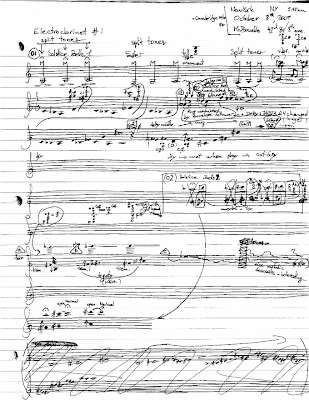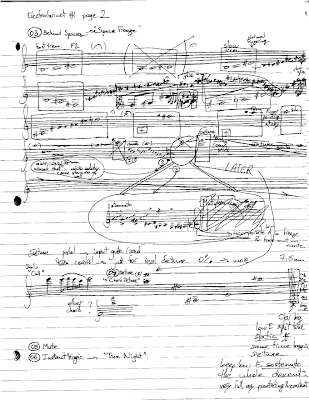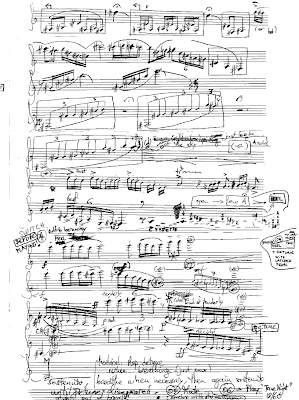Electroclarinet 1 - From draft to score
Looking for the studio album? Visit www.electroclarinet.com
 |  |
The draft of Electroclarinet 1

|  |
My score for the première of Electroclarinet 1
A serial composition inspired by Steve Vai and Wolfgang Amadeus Mozart
As you may recall, this title was one of the slides in my Shanghai Max MSP (and beyond) presentation. The Steve Vai influence may be obvious (when I was composing, I discovered his double DVD Where the Wild Things Are.) So I'll try to highlight how the piece is related to twelve-tone serialism and Mozart.
The easiest link is Mozart: you might have already recognized that the last minute of Electroclarinet 1 is no more than 18/60 - True Night, a Mozart-inspired minute of music. Now, how is this music serial?
Well, it turns out that 18/60 - True Night is not just the last section of Electroclarinet 1, but really a seed for the whole composition. You can see that by comparing the draft above with the score of 18/60 - True Night.
We can also trace the three first pitches of True Night throughout Electroclarinet1:

4 transpositions of the 3 note motive: that looks like a 12-tone series!
- the three opening pitches of the piece (F, G, A). They must be played as split tones, the kind of multiphonic sounds played with normal fingerings, and sounding especially rich on the lowest notes of the clarinet. I liked to make this naturally inharmonic spectrum interact with the inharmonicity of the live electronics, a dynamic frequency shifting (ring modulation).
- the three successive high notes (Ab, Bb, C). These are multiphonics over trills, or rather tremolos. After writing the high pitches, I figured out which exact tremolos I wanted by trying out with the clarinet.
- (B, C#, D#) are played as multiphonics as well, the lowest pitches of the multiphonics being shadow "false fundamentals" of the high fingered pitches.
- Finally, (D, E, F#) start the last minute of the piece. And to round off the composition, the three last pitches are the same as the first ones (F, G, A) - that's quite a classical approach, of course.



Comments
Post a Comment